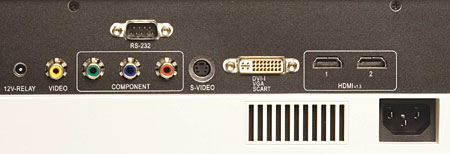Big Screens, Small Prices Optoma HD80
Optoma’s entry-level projectors have consistently fared well in our roundups and Face Offs, so it was with great interest that we received the HD80. The company recently dropped the price from $2,999 to $2,699, making it one of the least expensive 1080p models on the market—at least until Optoma’s new $2,599 HD803 hits the shelves (it should be available by the time you read this). Despite being the least expensive, the HD80 is the most stylish, with an attractively curvaceous, pearlescent white cabinet and shiny silver lens. The small remote is fully backlit, with dedicated source and aspect-ratio buttons.

The HD80 doesn’t skimp on video inputs, including two HDMI 1.3, one DVI, and one component video. It also has RS-232 and 12-volt trigger ports. Where it does reveal its budget nature is in the areas of setup and ergonomics. It lacks significant horizontal and vertical lens shift, the adjustable front feet are imprecise, and the zoom is limited to 1.2x, so I had a very difficult time aligning the HD80’s image with my screen. Keystone correction is available, and you can configure the projector for ceiling, tabletop, front, or rear projection.

After setup, I noticed a hint of light spray off the top right side of the screen, and the HD80’s aspect ratio didn’t precisely match that of my screen; there was about an inch of unused space at the top. Speaking of aspect ratios, you only get four basic choices (4:3, 16:9, Native, and Letterbox), and there’s no automatic aspect-ratio detection, both of which were more bothersome when watching TV signals that are shaped and stretched in all sorts of ways. Optoma does offer an anamorphic lens attachment for this projector.
 The good news is, once you get past the ergonomic issues, the HD80 renders an attractive image, particularly through the HDMI inputs. Out of the box, the projector’s color temperature is noticeably cool (or blue). White-balance controls are user-accessible; after calibration, the HD80 tracks very close to D65 across the board. Its blue color point is a bit undersaturated, but the remaining colors are the most accurate in the roundup. Skintones and colors looked pleasingly natural, no matter the source. Uniformity was a bit of an issue; with an all-white test pattern or black-and-white content, the left side of the screen was redder than the right.
The good news is, once you get past the ergonomic issues, the HD80 renders an attractive image, particularly through the HDMI inputs. Out of the box, the projector’s color temperature is noticeably cool (or blue). White-balance controls are user-accessible; after calibration, the HD80 tracks very close to D65 across the board. Its blue color point is a bit undersaturated, but the remaining colors are the most accurate in the roundup. Skintones and colors looked pleasingly natural, no matter the source. Uniformity was a bit of an issue; with an all-white test pattern or black-and-white content, the left side of the screen was redder than the right.
You can fine-tune the HD80’s light output and black level in a number of ways: The Brite mode boosts light output, the 16-step iris adjusts the amount of light coming through the lens, and the Image AI mode automatically adjusts the lamp’s brightness based on the picture content. The best contrast ratio we obtained was 1,691:1, the lowest in the roundup. However, the HD80 has the best ANSI contrast, and its respectable 0.004-foot-lambert black level, accurate color palette, and great detail allowed HD demo scenes from Mission: Impossible III, V for Vendetta, and Kingdom of Heaven to look rich and involving in a dark room. At these settings, the light output is a low 6.76 ft-L, so brighter HDTV signals, while colorful and well detailed, lacked that extra bit of pop. Turn on the Brite mode and open the iris, however, and this projector suddenly becomes the brightest in the group, so there is some flexibility to tailor the output to different sources and viewing conditions.
Unfortunately, the HD80 is very loud with the Brite mode on or Image AI engaged. Plus, the Image AI function is slow enough that I often saw the picture’s brightness shift, which was distracting. So ultimately, I turned these features off. Sure, it lowered the contrast ratio to 1,250:1, but it was a more pleasant viewing experience.
The HD80 passed our 1080i deinterlacing tests through both the component video and HDMI inputs. It cleanly rendered the staircase in chapter 8 of the Mission: Impossible III HD DVD, which trips up many processors. The HDMI inputs accept both 1080p/60 and 1080p/24. Unfortunately, the projector’s handling of 480i sources wasn’t as consistent. It produced jaggies in both my Gladiator and Bourne Identity demo scenes, and 480i sources generally looked soft; thus, I recommend that you mate the HD80 with a good upconverting DVD player.
While somewhat noisy through the component video inputs, the HD80’s HDMI image is very clean. The smoke in Ladder 49 looked natural, and the light-to-dark transitions in my Lost: The Complete Second Season demo scene were smooth. The model’s 10-step noise-reduction circuit causes all sorts of blurring and tracing issues with dark content, so you should avoid using it. As the only DLP projector in the group, the HD80 exhibited significantly less motion blur than the LCD projectors with test patterns from my FPD Software Group Blu-ray disc.
If you’re willing to sacrifice some convenience and ergonomic features to save a few hundred dollars, then the HD80 is worth a look. When paired with a good 1080i or 1080p player, its pleasing color, solid blacks, and great detail make for an enjoyable big-screen movie experience.




























































